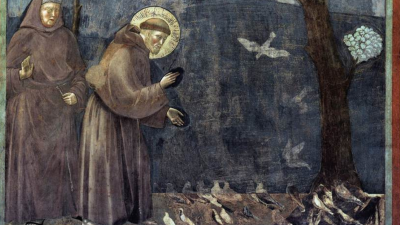Francis and Nature (Part 2)
St. Francis of Assisi
St. Francis’ writings did not adopt images from his experience of nature, but rather from Sacred Scripture. Did you know Francis most often points to animals and their obedience to God?

People are surprised to learn that the Early Rule of the friars instructed the brothers not to own pets – as well they were not to ride horses. These rules are only partly about poverty; they encouraged friars not to treat animals as objects or possessions. And, in the case of horseback riding, his rule distanced the friars from the proud world of chivalry. Later in his life when sickness compelled him to ride, Francis always preferred a donkey.
In his own writings, Francis does not adopt images from his experience of nature, rather he took those images from Scripture. In the five passages outside the Rules where he mentions animals, only once does he go beyond the imagery from Scripture, and it is to hold up animals as an example of obedience to God.
Francis loved living things; they moved him to prayer and, most typically, to compassion, especially toward animals themselves. His first response to nature was to praise its Creator and to love the creature. Animals were for him a gift. It is this affinity for God’s creation and the response of praising God that seems most remembered about Francis in the stories collected after his death. What impressed them was his deep affinity for creatures, his habit of speaking to them with affection, and their attraction to him. Yet for Francis they remained creatures. In accord with the Gospel precept to “eat what is put before you,” Francis, alone among medieval religious founders and reformers, permitted the eating of meat—a rule he followed himself. He was not a vegetarian.
Augustine Thompson describes Francis’ very personal encounter with nature: “Francis took spontaneous joy in his encounters with animals, especially when they responded to him. Once at the Porziuncula he found a cricket on a branch of the fig tree outside his door. He coaxed it onto his finger and said: ‘Sing, my sister Cricket!’ The little creature sang. For an hour he held the cricket with pure delight. For a whole week, each morning when he came out, he found what seemed to him the same cricket, and it would sing for him. This brought him great consolation. Eventually, he allowed the creature its freedom. He ‘gave her permission’ to go wherever she wanted. She took off and flew away.”
“Francis’ respect for animals’ freedom and dignity shows him at his most sensitive and attractive. He could not bear the thought of a living creature caught in a trap or destined to be killed, even for food—despite his rejection of religious abstinence from meat. As Francis and the brothers walked the highways of Umbria after a rain, he would stop to pick up and move worms that had crawled on the road to escape the water. He could not bear the thought of people stepping on them. He expressed the same compassion to animals brought to him or the brothers for food. Once, at Greccio, a brother brought in a hare caught in a trap, doubtless proud of having provided a meal for the community. Francis took the hare, held it, stroked it for some time, and then went out and released it. The small creature must have found a sense of security beside Francis, for it would not leave his side; even when chased off, it found its way back to his feet. Eventually, he had one of the brothers take it to the deep woods.”
Francis exhibited something more, a personal affection and love of them. In a world where nature was typically exploited as a source of resources or feared as dangerous, those who knew him commented on Francis’s affection for animals and delight in creation.
Once while traveling near Bevagna in the Spoleto valley, Francis spied a large flock of birds in a field by the side of the road. Delighted by them, he approached and addressed them with his familiar greeting, “The Lord give you peace.” He was even more delighted that they did not fly away, even as he walked into their midst. He voiced great praise to God for this and urged his sister birds to do so too. This was something they did, singing, spreading their wings, and taking flight as he blessed them with the sign of the cross. This incident, later elaborated into the famous “Sermon to the Birds,” exemplifies Francis’ relationship to nature: delight at its presence and greater delight when animals did not fear him, both leading, to praise of the Creator who made them.
On occasion, Francis pointed to animals as an opportunity to reflect on the Gospels and their message. Once while walking with the brothers they passed a peasant with a flock of goats, in the midst of which was a single lamb. Francis recalled Christ’s allegorical use of sheep and goats, and since this lamb reminded him of the Lamb of God, alone among the Pharisees and high priests before his Passion, he began to weep. For Francis, lambs were always images of Christ.
For Francis, all creation pointed back to Christ and to the Creator. All nature was a reminder to praise and give glory to God.